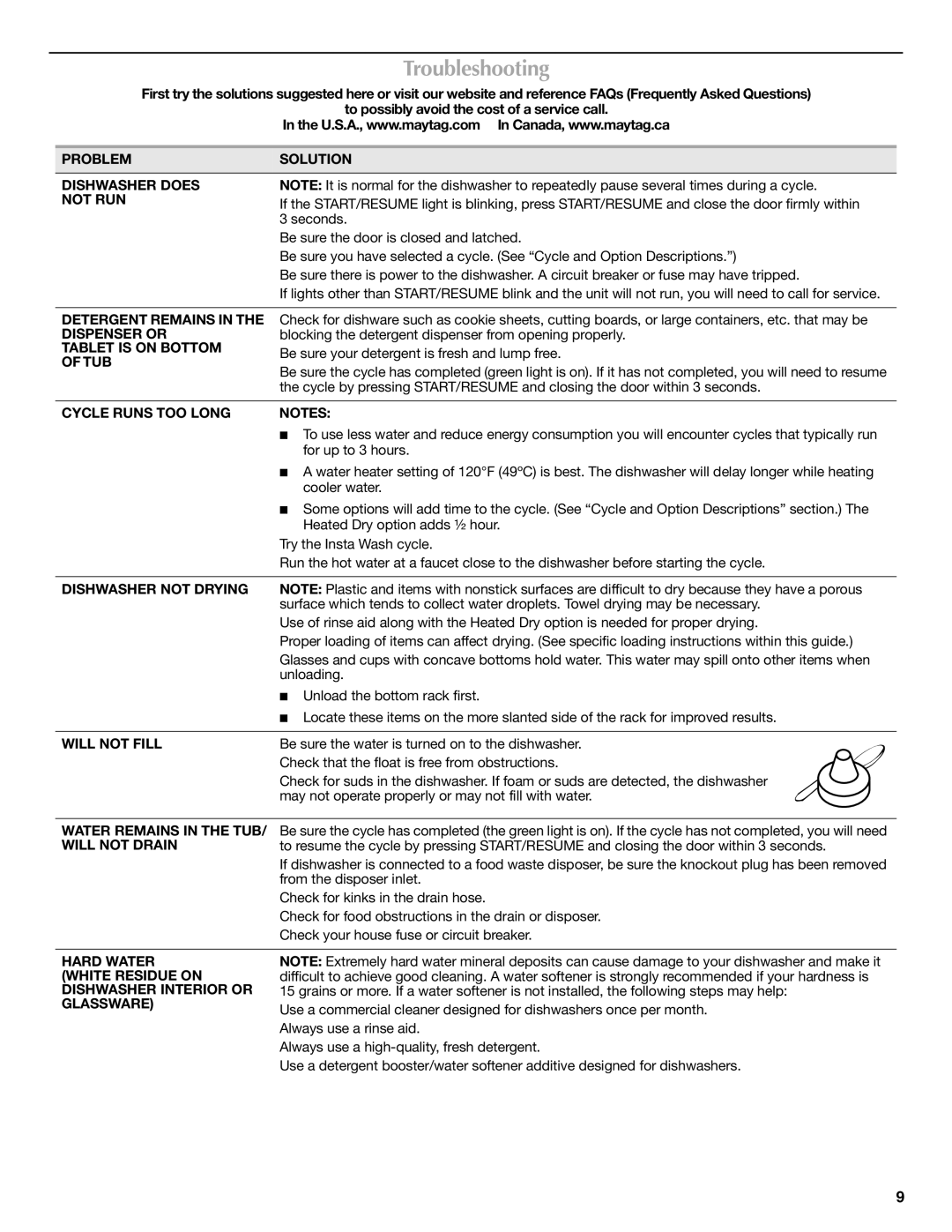
Troubleshooting
First try the solutions suggested here or visit our website and reference FAQs (Frequently Asked Questions)
to possibly avoid the cost of a service call.
In the U.S.A., www.maytag.com In Canada, www.maytag.ca
PROBLEM | SOLUTION | |
|
| |
DISHWASHER DOES | NOTE: It is normal for the dishwasher to repeatedly pause several times during a cycle. | |
NOT RUN | If the START/RESUME light is blinking, press START/RESUME and close the door firmly within | |
| ||
| 3 seconds. | |
| Be sure the door is closed and latched. | |
| Be sure you have selected a cycle. (See “Cycle and Option Descriptions.”) | |
| Be sure there is power to the dishwasher. A circuit breaker or fuse may have tripped. | |
| If lights other than START/RESUME blink and the unit will not run, you will need to call for service. | |
|
| |
DETERGENT REMAINS IN THE | Check for dishware such as cookie sheets, cutting boards, or large containers, etc. that may be | |
DISPENSER OR | blocking the detergent dispenser from opening properly. | |
TABLET IS ON BOTTOM | Be sure your detergent is fresh and lump free. | |
OF TUB | ||
Be sure the cycle has completed (green light is on). If it has not completed, you will need to resume | ||
| ||
| the cycle by pressing START/RESUME and closing the door within 3 seconds. | |
|
| |
CYCLE RUNS TOO LONG | NOTES: | |
| ■ To use less water and reduce energy consumption you will encounter cycles that typically run | |
| for up to 3 hours. | |
| ■ A water heater setting of 120°F (49ºC) is best. The dishwasher will delay longer while heating | |
| cooler water. | |
| ■ Some options will add time to the cycle. (See “Cycle and Option Descriptions” section.) The | |
| Heated Dry option adds ½ hour. | |
| Try the Insta Wash cycle. | |
| Run the hot water at a faucet close to the dishwasher before starting the cycle. | |
|
| |
DISHWASHER NOT DRYING | NOTE: Plastic and items with nonstick surfaces are difficult to dry because they have a porous | |
| surface which tends to collect water droplets. Towel drying may be necessary. | |
| Use of rinse aid along with the Heated Dry option is needed for proper drying. | |
| Proper loading of items can affect drying. (See specific loading instructions within this guide.) | |
| Glasses and cups with concave bottoms hold water. This water may spill onto other items when | |
| unloading. | |
| ■ Unload the bottom rack first. | |
| ■ Locate these items on the more slanted side of the rack for improved results. | |
|
| |
WILL NOT FILL | Be sure the water is turned on to the dishwasher. | |
| Check that the float is free from obstructions. | |
| Check for suds in the dishwasher. If foam or suds are detected, the dishwasher | |
| may not operate properly or may not fill with water. | |
|
| |
WATER REMAINS IN THE TUB/ | Be sure the cycle has completed (the green light is on). If the cycle has not completed, you will need | |
WILL NOT DRAIN | to resume the cycle by pressing START/RESUME and closing the door within 3 seconds. | |
| If dishwasher is connected to a food waste disposer, be sure the knockout plug has been removed | |
| from the disposer inlet. | |
| Check for kinks in the drain hose. | |
| Check for food obstructions in the drain or disposer. | |
| Check your house fuse or circuit breaker. | |
|
| |
HARD WATER | NOTE: Extremely hard water mineral deposits can cause damage to your dishwasher and make it | |
(WHITE RESIDUE ON | difficult to achieve good cleaning. A water softener is strongly recommended if your hardness is | |
DISHWASHER INTERIOR OR | 15 grains or more. If a water softener is not installed, the following steps may help: | |
GLASSWARE) | Use a commercial cleaner designed for dishwashers once per month. | |
| ||
| Always use a rinse aid. | |
| Always use a | |
| Use a detergent booster/water softener additive designed for dishwashers. |
9
